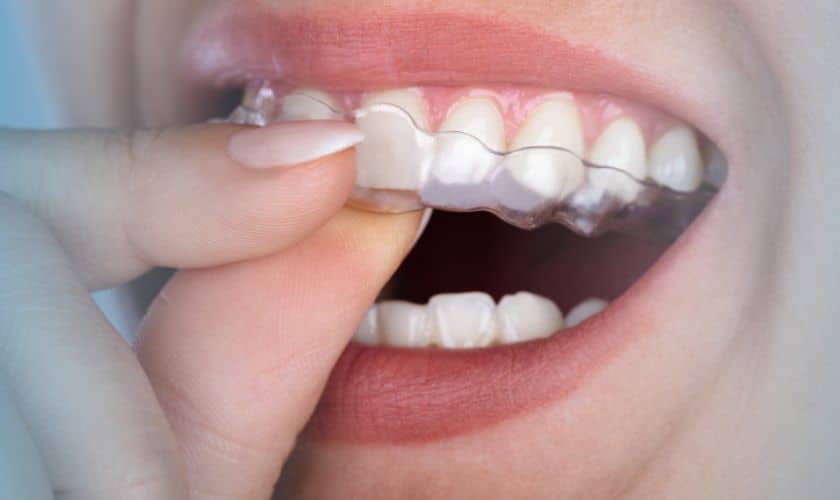Invisalign is a revolutionary orthodontic treatment that uses clear aligners to adjust teeth gradually into their desired positions. Invisalign can be used to treat many dental issues, including overbites. This article will discuss an overbite and how Invisalign can help fix it.
What Is An Overbite?
An overbite occurs when your upper front teeth overlap your bottom front teeth more than the normal amount. In some cases, an overbite may even cause the lower front teeth to sit behind the upper front teeth completely. There are two types of overbites: Class I and Class II. A Class I overbite occurs when the upper teeth overlap the lower teeth by up to 50%, while a Class II overbite is when the upper teeth overlap the lower teeth by more than 50%.
Signs and Symptoms of an Overbite
Common signs and symptoms of an overbite include difficulty closing your lips, pain in the jaw joint, speech impairments, and excessive wear on the lower front teeth. In severe cases, it can also cause headaches or neck pain. You must visit your dentist immediately if you notice any of these symptoms.
Causes of an Overbite
An overbite can be caused by various factors such as genetics, thumb sucking during childhood, misaligned jaws, or teeth that are too large for your mouth. Sometimes, it can also be caused by poor oral hygiene or an accident.
Treating an Overbite
The most common treatment for an overbite is orthodontic treatment, such as Invisalign. Invisalign involves wearing custom-made aligners that gradually shift the teeth into their desired positions. Invisalign is a comfortable, convenient, and discreet way to treat an overbite without metal brackets or wires. In addition, Invisalign provides faster results than traditional braces in most cases.
How Does Invisalign Fix An Overbite?
Invisalign uses clear plastic aligners to move the teeth into the desired position gently. Invisalign aligners are custom-made to fit each patient’s mouth and are changed every two weeks for a new set of aligners. With Invisalign, patients can achieve their desired results without metal brackets or wires. Invisalign is also more comfortable than traditional braces, providing faster results in most cases. In addition, Invisalign aligners can be removed for eating, brushing your teeth, and other activities, so you don’t have to worry about food getting stuck between brackets or wires.
The Invisalign Process
The Invisalign process begins with taking an impression of your teeth which will be used to create a 3D image of your teeth. Invisalign uses this 3D image to create a customized treatment plan for you. During the Invisalign process, you’ll need to wear your aligners for 22 hours daily and change them out every two weeks as prescribed by your Invisalign provider. In addition, you’ll need to visit your Invisalign provider every six to eight weeks for progress checks.
Benefits of Invisalign
The biggest benefit of Invisalign is that it offers faster results than traditional braces in most cases. In addition, Invisalign aligners are much more comfortable than metal brackets and wires. They can be removed for eating, brushing your teeth, and other activities, so you don’t have to worry about food getting stuck between brackets or wires. Invisalign also offers a discreet treatment option since the aligners are nearly invisible when worn.
Risks of Invisalign
The biggest risk with Invisalign is that it may not be suitable for all orthodontic issues. In addition, Invisalign requires you to wear the aligners for 22 hours each day and follow your Invisalign provider’s instructions closely to achieve the desired results. If you don’t follow these instructions, you may experience delays in achieving your desired results.
Conclusion:
Invisalign is a comfortable, convenient, and discreet way to treat an overbite without metal brackets or wires. In most cases, Invisalign can be used to fix an overbite. In addition, Invisalign provides faster results than traditional braces in most cases. However, Invisalign may not be suitable for all types of orthodontic issues. It requires you to wear the aligners for 22 hours each day and follow your Invisalign provider’s instructions closely to achieve the desired results.
FAQs
Yes, Invisalign is usually effective in treating an overbite. Invisalign utilizes custom-made aligners that gradually shift the teeth into the desired position to correct an overbite. In addition, Invisalign provides faster results than traditional braces in most cases.
The Invisalign process usually takes 9-18 months to complete depending on the severity of your orthodontic issue. In addition, you’ll need to visit your Invisalign provider every six to eight weeks for progress checks.
Yes, there are some risks associated with Invisalign. Invisalign may not be suitable for all types of orthodontic issues. It requires you to wear the aligners for 22 hours each day and follow your Invisalign provider’s instructions closely to achieve the desired results. If you don’t follow these instructions, you may experience delays in achieving your desired results

